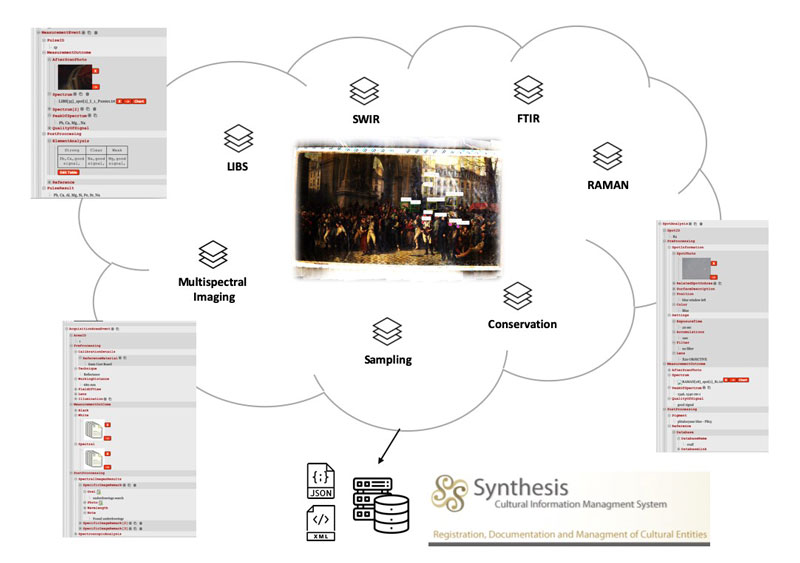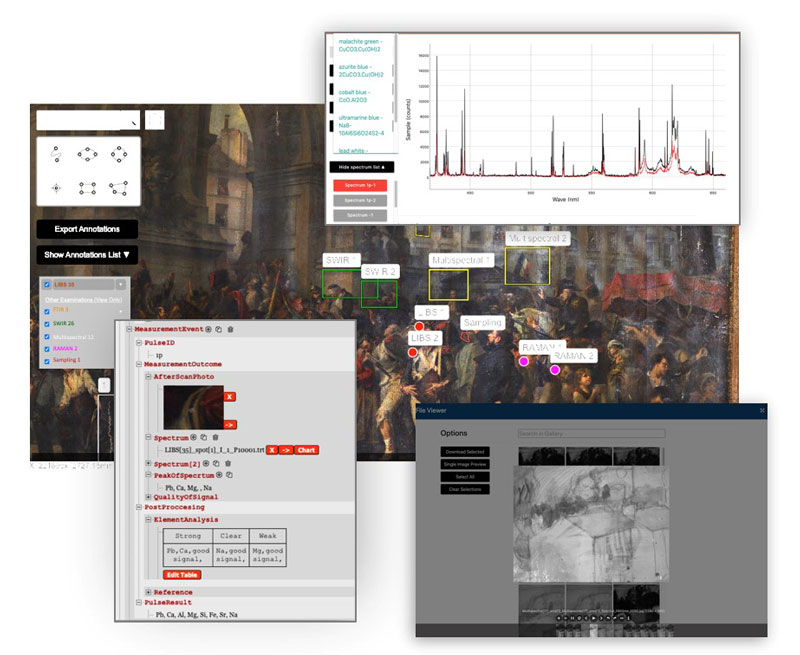by Kostas Petrakis, Manos Paterakis and Dimitris Angelakis (ICS-FORTH)
Heritage Annotator is a tool to support the creation and management of semantically structured annotations on digital representations of cultural heritage objects for the documentation of the acquired data and the results of analytical examinations, as well as of conservation condition reports or remedial works performed on the objects.
A vast area of research in Heritage Sciences concerns the documentation of analytical examinations and conservation interventions on heritage objects carried out by different actors. Archaeologists, conservators, engineers, material scientists, curators, and restorers of cultural assets are constantly enriching the knowledge and information about heritage artefacts. As expected, this knowledge consists of highly heterogeneous data produced by different procedures. Current practices make use of spreadsheets or text files to organise the information. Although these forms offer data analysis and scholarly interpretation, they pose problems including: i) difficulty for collaborative but controlled documentation by a large number of users, ii) an inability to represent the details from which the documented relations are inferred, iii) difficulty in extending the underlying data structures as well as in combining and integrating data from multiple and diverse sources and procedures, and iv) limitations in reusing the data beyond the context of a particular research activity.
The need to store and identify this information under a common denominator is more than obvious. The basic idea for the Heritage Annotator is to meet this need by allowing users to directly annotate images of the object, whether it is a painting, a sculpture, a building, or a work of art in general. This approach creates a clear visual overview of the procedures that have been followed and the location from which this information was derived. The annotation data structure makes use of existing standards for information documentation and publication (CIDOC-CRM) [L1], focusing on semantic interoperability and the production of searchable data of high value and long-term validity. These data are stored and managed on a common database, which is provided by the Synthesis Documentation System of FORTH [1] (see Figure 1).

Figure 1: An example of how Heritage Annotator tool can be accessed by the Synthesis documentation system.
In this article, we describe the process of documenting on the same digital representation of a heritage object, and analytical techniques that provide different information and present different degrees of invasiveness, which implies a hierarchical protocol for their sequential application. Additionally, to allow the user to preview and annotate the areas of examination with high accuracy, regardless of the scale of operation, a function of dynamic zoom is available. As an example, MultiSpectral Imaging on an area, microRAMAN at micro scale, and macroLIBS (Laser Induced Breakdown Spectroscopy) inducing a macro-spot of ablation, SWIR (Short-wave infrared) and FTIR (Fourier-transform infrared spectroscopy) examinations are presented (see Figure 2).

Figure 2: Overview of how the data are stored.
All annotations are linked to the same digital image of the heritage object, creating rich, structured knowledge, which helps scientists from different fields to combine their data and cooperate on curation and conservation. This means that each examination has its own different sematic schema for the annotations. Data are stored on a different record for every analytical examination into the same database and the tool gives the ability to link up annotations with scientific examination records. Advanced search is available on specific annotation parameters and results, and the tool provides a mechanism for exporting/importing examination records in xml format. Synthesis documentation system provides a detailed overview of all cultural heritage objects and all the linked activities that have been done in the past (see Figure 3).

Figure 3: Heritage Annotator interface and functionalities.
Heritage Annotator’s basic functionality is that it allows the user to create/edit and delete annotations. It also provides the ability to view all the related annotations on the same object supporting text search on all annotations of an object. Additionally, the tool supports spatial search for annotations in a specific area and makes use of multiple image layers (e.g., a different photo of the same object after a long period or intervention). Heritage Annotator is also capable of deep zooming, can support large image files by using tiles, and handles chart visualisation for spectral data. Finally, the tool supports chart comparison with pigment refence databases facilitating pigment comparisons for those performing the examination. Further information about this tool can be found here [L2].
Acknowledgment
The financial support of this work has been provided by the project “PROTEAS” (Advanced system for collection and management of analytical data for documentation and conservation of large-scale paintings in an open laboratory, MIS 5069984), which are respectively implemented under the “Action for the Strategic Development on the Research and Technological Sector” and “RESEARCH-INNOVATE-CREATE II” and are funded by the Operational Program ¨Competitiveness, Entrepreneurship and Innovation¨ (NSRF 2014-2020) and co-financed by Greece and the European Union (European Regional Development Fund).
Links:
[L1] https://www.cidoc-crm.org/
[L2] https://demos.isl.ics.forth.gr/Heritage-Annotator/
Reference:
[1] P. Fafalios et al.: “Towards Semantic Interoperability in Historical Research: Documenting Research Data and Knowledge with Synthesis” In Proc. of 20th Int. Semantic Web Conf. (ISWC 2021), 2021.
Please contact:
Kostas Petrakis, ICS-FORTH, Greece
+30 2810 391488,











